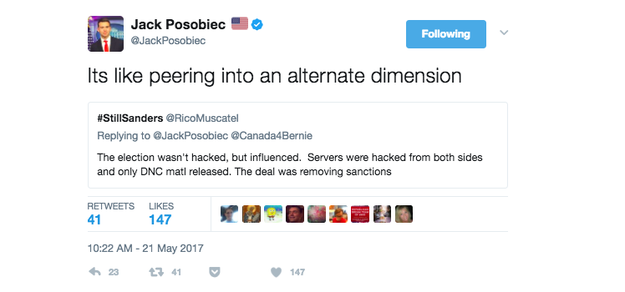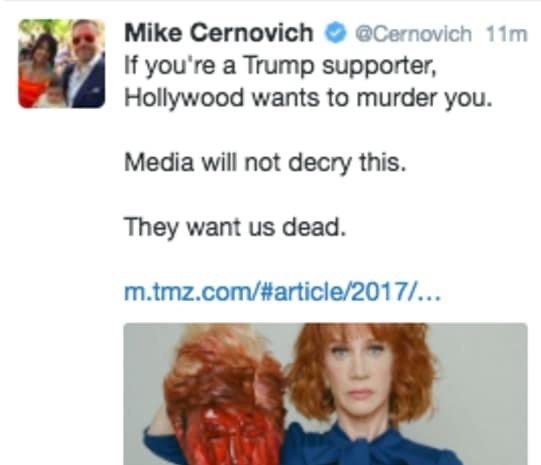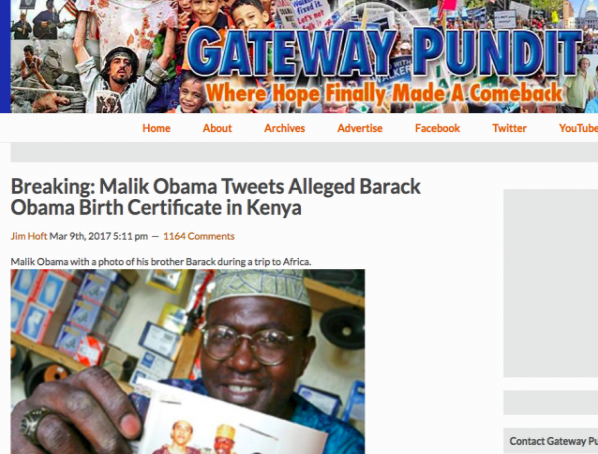
On a blistering 107-degree Phoenix evening this August, thousands came to watch Donald Trump cobble together an alternate reality.
For 16 minutes, the president leaned against the podium and outlined a grim threat facing the those in the room — a poisonous influence that was “fomenting divisions” in the country.” He was, of course, referring to the media, decrying the press as "liars" and "sick people," framing them as a fundamental threat to the United States. "I really think they don't like our country. I really believe that," he told the crowd.
He defended his comments about the recent Charlottesville protests by quoting himself at length, but omitted the key “both sides” phrase that drew ire from the media and his critics. He claimed as fact that the press would never dare show the size of his rally crowd, even though CNN’s cameras had repeatedly zoomed out to show the scope of the audience. Trump didn’t seem to mind and neither did those in attendance. There was no way his supporters in the room could know what CNN was doing with its cameras. Nor were they likely to go back and listen to or read transcripts of the speech to scour for inconsistencies when the primary source stood before them telling them what transpired.
Outside the rally, Trump’s remarks set off a familiar, self-perpetuating cycle — an awkward media dance of fact-checking and contextualizing that, no matter how objective, paints the media as Trump sees it: an oppositional force. Seconds after Trump wrapped, CNN’s Don Lemon denounced the speech, calling it “a total eclipse of the facts” and “an an attempt to rewrite history."
Across the internet, the reaction to Lemon’s from Trump supporters was vindication. “As an experiment watched CNN's Don Lemon's opening diatribe of unending hostility to Trump.No wonder Trump attacked media intensely,” former speaker of the House Newt Gingrich tweeted shortly after the speech.
The narrative had been set. Trump claims he's a victim, blames the media; the media becomes combative; his victimhood deepens, becomes part of the identity of his followers. Trump creates his version of reality and we end up in it one way or another.

Phoenix was no isolated incident. Some version of this cycle played out almost daily in 2017. During Trump’s first year in office, it’s become clear that the internet and political culture at large aren’t just fractured or divided. They are operating in wholly separate universes, each armed with its own sets of facts, fomented by White House-led war on the media and amplified by easily weaponized social platforms. 2017 was the year we lost our shared reality: a year where a pro-Trump media pushed conspiracy-theorizing and hyperpartisanship further toward the center of popular culture, revealing not just parallel media institutions, but parallel universes of information.
Trump creates his version of reality and we end up in it one way or another.
You could see this in many of 2017’s most consequential stories. Former FBI director James Comey’s congressional testimony about his firing this summer was a “nothingburger” according to the pro-Trump media, while some cable chyrons — “COMEY: TRUMP ADMIN LIED ABOUT ME & FBI.” — suggested a profoundly different interpretation. Mainstream media treated reports of Donald Trump Jr.’s 2016 campaign meeting with a Kremlin-linked lawyer as potential evidence in a building Russia collusion case; on #MAGA Twitter, reports became a “liberal Fake News...coordinated attack on Don Jr.” and, in some circles, proof of a Democratic party plot to set up Trump’s son.
Even at the end of 2017, there’s little consensus on each day’s biggest stories. This fall, a visit to Breitbart or Fox News would have likely revealed all caps headlines claiming bombshell reports of Hillary Clinton’s (as yet unsubstantiated) participation in a quid pro quo agreement to accept payment for approval of a Russian Uranium deal — a story largely dismissed or uncovered by mainstream media outlets. Depending on the makeup of your feed, it is entirely possible to view special counsel Robert Mueller and his team as intrepid, ruthless truth-seekers or as reckless, unhinged hired-guns carrying out a partisan coup against the president.
Partisan news bias is far from new, but in 2017, it took on a more sinister tone.
On June 14th, it took under an hour for the pro-Trump media to blame anti-Trump leftists and the mainstream media for an attack on Congressional Republicans at a baseball field in Virginia. Before any confirmation of the shooter’s identity, numerous pro-Trump media personalities leveled blame on the mainstream media, and far-right commentators and Twitter personalities dredged up old examples of what they deemed to be incitements of violence on the left. Roughly 90 minutes after the attack, Infowars' Paul Joseph Watson published an article alleging the shooting was a "media-inspired terror attack." And when reports confirmed that the shooter had far-left political views that likely influenced his attack, the pro-Trump media seized on it as proof of a larger narrative of political violence by the left, one rooted in a handful of cherry-picked examples.
According to the pro-Trump media, to be a Trump supporter in 2017 was to be unfairly labeled as a racist, bigot, sexist, and Nazi, and to be under constant assault by a liberal media apparatus hell-bent on delegitimizing the president by any means necessary. A controversial New York performance of Julius Caesar this summer — in which the title character is played by a Trump doppelganger and assassinated via a violent stabbing — was portrayed by Trump supporters as a dog whistle for an attempt on the president’s life. A tasteless and quickly denounced photoshoot by comedian Kathy Griffin holding Trump’s severed head was held forth across the pro-Trump media as a shining example of "the intolerant left." Griffin’s ties to CNN — which quickly dismissed the comedian from an annual hosting gig — led the pro-Trump media to start the hashtag #CNNIsISIS. The conspiracy site Infowars started a contest offering $1,000 to “anyone who is seen on TV with a ‘œCNN is ISIS’ t-shirt or sign.”

The mainstream media responded to the pro-Trump rhetoric this year by defensively doubling down on its commitment to reporting the truth. Early in 2017, the Washington Post unveiled a new tagline — “Democracy Dies in Darkness,” while the Times ran an ad campaign to remind readers that “Truth is hard.” In the fall, CNN ran a “facts first” marketing campaign complete with a mission statement that argued, “while opinions matter, they don't change the facts. That's why, at CNN, we start with the facts first." Across cable news and social media, journalists constantly fact-checked, decried, and debunked conspiracy theories, fake news, and “alternative facts.”
Not that the other side seemed to hear or even mind. To the pro-Trump media, it was irrelevant that its loudest voices assumed and reported the Virginia shooting was a politically motivated attack by a leftist before law enforcement released the name of the shooter. Or that the Julius Caesar performance was intended by its directors as a commentary on 2017’s divisive political culture. Or that Griffin's photoshoot was immediately decried as tasteless by people at all coordinates of the political spectrum. It did not matter that the pro-Trump media has declared the mainstream media "fake news" while championing stories that have either been proven false (the #Pizzagate child sex ring at Comet Pizza) or which have been unsubstantiated by credible evidence (the reports linking murdered DNC staffer Seth Rich's laptop to Wikileaks). And it didn’t matter that the pro-Trump media refused to denounce political violence when a Republican billionaire running for congress in Montana body slammed a reporter in May.

And so it continued. The year was defined by two universes of information in which — as journalist Joshua Green wrote this year — “the same set of facts is rearranged to compose an entirely different narrative.” In the end, we had a collective online nervous breakdown that bred conspiratorial thinking among the president’s biggest supporters but also his most ardent critics. In 2017, timelines were clogged by breathless viral tweetstorms from Blue Detectives: vigilante investigators hellbent on exposing multi-dimensional corruption in Trumpland. By stringing together observations, charts, and images, these “investigators” spent the year claiming to have mapped vast universe of corruption, the particulars of which they promised would be revealed shortly. The mainstream media, too, while largely rising to the journalistic occasion, has played into the hands of the pro-Trump media’s ‘fake news’ trolling efforts. On multiple occasions, outlets like 60 Minutes, The New York Times, and NBC News allowed themselves to be bested by the pro-Trump media. And, especially of late, the mainstream press has made numerous reckless reporting errors — most chronicled by the Intercept’s Glenn Greenwald — in a sometimes frenzied effort to find a smoking gun in the Trump-Russia collusion narrative.
That the most contentious battles were waged on the internet is no coincidence. Tech’s biggest platforms, including Facebook, Twitter, and YouTube, powered the push of conspiracy theories from the outskirts of political discourse to its heart. Divisive, factually dubious hyperpartisan news sites — allowed to grow mostly unchecked by Facebook — made shady publishers small fortunes while pushing conspiracy theories and fake news. As a deep analysis of hundreds of hyperpartisan sites and pages showed earlier this year, the “American online political discourse is powered by a mix of money and outrage.”
The platforms’ founders and stewards spent the year first downplaying and then slowly coming to grips — thanks, in part, to congressional scrutiny — with the influence of their companies in everything from fake news to geopolitical electoral interference. Yet the platforms themselves were virtually powerless to stop bad actors from poisoning political and cultural discourse with a steady stream of propaganda, misinformation, and openly divisive content.
While the platforms have started to accept responsibility, there’s been little real progress throughout the year. Twitter was too committed to its free speech maximalist ideology to definitively address how to treat a President who uses it to troll North Korea about its nuclear weapons tests or to curb routine abuse on the platform. Facebook and YouTube’s inadequacy surrounding breaking news became more and more obvious with each mass shooting. Meanwhile, the platforms’ algorithms continue to dredge up and promote content to push users down radicalizing rabbit holes.
Despite being dragged in front of congressional committees to account for their role in foreign misinformation campaigns, the companies appear to have no real answers for the problems their unprecedented scale creates. “I wish I could tell you we're going to be able to stop all interference, but that wouldn't be realistic,” Facebook CEO Mark Zuckerberg said in a September message to users concerning the platform’s pledge to stop foreign governments from hijacking the platform to influence voters.

It’s not just state-sponsored actors exploiting platforms to create alternate realities. In 2017, political grifters, trolls, and hackers took advantage of algorithmic flaws and moderator complacency to wage elaborate social influence campaigns. Across chat platforms like Discord, teenagers and pro-Trump supporters plotted and executed elaborate trolling campaigns against media outlets and anti-Trumpers, creating caustic hashtags and bespoke shock memes. And politically minded engineers like Microchip, “a notorious pro-Trump Twitter ringleader,” orchestrated automated networks of Twitter accounts to help push trending topics and advance narratives. A new media narrative emerged: Our online reality was being gamed and manipulated by nefarious bots — part of what the New York Times called a “terrifying scourge on democracy.” Still, the Great Bot Crisis paled in comparison to the human media machine — operated by a new class of vocal influential, and controversial Twitter pundits — bent on pushing a pro-Trump narrative and trolling its opponents at all costs.
We had a collective online nervous breakdown that bred conspiratorial thinking among the president’s biggest supporters but also his most ardent critics.
None of this seems to be going away any time soon. Just take Alabama. If you were asked to draw up a post-truth nightmare scenario at the start of the year, it would probably look a lot like the Alabama special election: A contentious, polarizing political contest is turned on its head by a seemingly clear-cut sexual abuse allegations, backed up by a wealth of credible media reports. But rather than form consensus, these reports served only to divide. Far-right media and the Republican candidate Roy Moore’s campaign itself repeatedly tried to discredit those reports, the accusers, and the entire political opposition party, effectively transforming a local election into a full-blown, national culture war. It became a referendum on Republicans, Democrats, the media and its bias, conspiracy theories, sexual harassment and treatment of women, religion, and, of course, our current president. And like every battle in 2017, it was fought by two sides armed with their own sets of facts. The race felt like a near-perfect encapsulation of how we got to now. And as practitioners of the online information wars grow more sophisticated, it will likely only get worse. Indeed, 2016's tenuous grasp on shared facts feels almost quaint by 2017 standards. Just as 2017 saw the professionalization of all the dirty tricks and tactics learned in 2016 election, there’s reason to believe this year was yet another prelude — proof of concept for ideas and behaviors that will be perfected in the year to come.
Any attempt at finding common ground or a shared reality will be an uphill fight against an online ecosystem that’s turned politics into a ledger with a running tally, where every outrage, misstep, and hypocritical line builds on the outrages that came before. It’s all available as manipulatable evidence to fit a narrative for each side, building in intensity, crescendoing to some unforeseeable but-somehow-still-inevitable conclusion: Impeachment! The death of the mainstream media! Somehow, both sides are winning even if nobody feels like they are.
from BuzzFeed - Tech https://www.buzzfeed.com/charliewarzel/2017-year-the-internet-destroyed-shared-reality?utm_term=4ldqpia
No comments:
Post a Comment